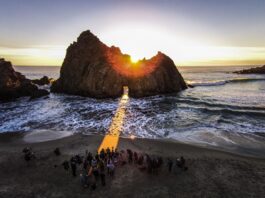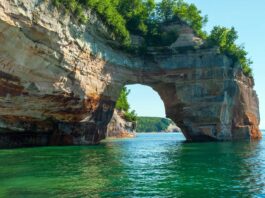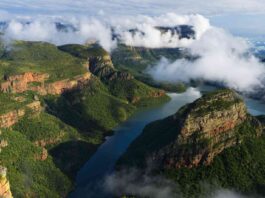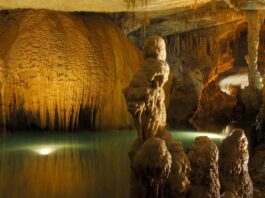The Dead Sea is a unique and captivating natural wonder located in the Middle East, bordered by Israel to the west and Jordan to the east. It is a saltwater lake renowned for its exceptionally high salt and mineral content, making it one of the saltiest bodies of water in the world. Here’s an introduction to the Dead Sea, including its history, geological features, and the experiences it offers.


Geologically, the Dead Sea is a landlocked salt lake situated in the Jordan Rift Valley, a geological depression formed by the separation of the African and Arabian tectonic plates. It is the lowest point on Earth’s surface, with its shores lying approximately 430 meters (1,410 feet) below sea level. The lake’s water comes from the Jordan River and various smaller streams, but it has no outlet, leading to high evaporation rates that contribute to its salinity.
The Dead Sea is famous for its unique composition of salts and minerals, including magnesium, potassium, calcium, and bromine. These minerals are believed to have therapeutic properties that benefit the skin and overall well-being. As a result, the area surrounding the Dead Sea has become a popular destination for health and wellness tourism.
The historical and cultural significance of the Dead Sea is profound. It is mentioned in religious texts such as the Bible, and its shores have been inhabited for thousands of years. The ancient cities of Sodom and Gomorrah, known for their biblical destruction, are believed to have been located near the Dead Sea. The area also witnessed the rise and fall of various civilizations, including the ancient Egyptians, Israelites, Romans, and Byzantines.
The unique properties of the Dead Sea, coupled with its breathtaking landscape, make it a popular tourist destination. People from around the world visit to experience its famous buoyancy, thanks to the high salt concentration, allowing visitors to effortlessly float on the surface of the water. The mineral-rich mud found along the shores is used for therapeutic purposes, with visitors often covering themselves in the mud and then rinsing off in the lake.

In addition to its natural wonders, the Dead Sea area offers various recreational and cultural activities. There are luxury resorts and spas that provide visitors with rejuvenating treatments and therapeutic experiences. The nearby nature reserves and hiking trails allow visitors to explore the desert landscapes and unique flora and fauna of the region.
While the majority of the Dead Sea’s shoreline is in Jordan, Israel also has a significant portion, and both countries have developed tourism infrastructure to cater to visitors. The Dead Sea is easily accessible from major cities like Amman in Jordan and Jerusalem in Israel.
However, it is important to note that the water levels of the Dead Sea have been receding over the years due to factors such as climate change, excessive water diversion, and mineral extraction. Efforts are being made by both countries to address this issue and preserve the unique ecosystem of the Dead Sea for future generations.
In summary, the Dead Sea is a remarkable natural wonder known for its high salt concentration, therapeutic properties, and historical significance. Whether you seek relaxation, cultural exploration, or an extraordinary natural experience, the Dead Sea offers a truly unforgettable journey.
Contents
- Geological Formation of the Dead Sea
- Formation Process
- Geological Features
- Environmental and Historical Implications
- Hydrology of the Dead Sea
- Unique Natural Features
- Extreme Salinity
- Water Density and Buoyancy
- Mineral-Rich Mud
- Health Benefits
- Rapid Evaporation and Sinkholes
- Geological and Climatic Conditions
- Archaeological Significance
- Environmental Concerns
Geological Formation of the Dead Sea

The geological formation of the Dead Sea, situated between Jordan and Israel, is a fascinating example of Earth’s dynamic processes. The Dead Sea is part of the Jordan Rift Valley, which is a segment of the larger Great Rift Valley that stretches from East Africa to Syria.
Formation Process
- Tectonic Activity: The formation of the Dead Sea is primarily the result of tectonic activity associated with the movement of the African and Arabian tectonic plates. These plates have been moving apart for millions of years, creating the rift valley in which the Dead Sea lies.
- Subsidence: As the tectonic plates pull apart, the land between them subsides, forming a graben, or a depressed block of the Earth’s crust. This subsidence has created the deep basin of the Dead Sea, which is about 430 meters (1,411 feet) below sea level, making it the lowest point on the Earth’s surface on dry land.
- Evaporation and Salt Concentration: Over time, water flowing into this basin from the Jordan River and smaller streams has no outlet to the sea, leading to high evaporation rates in the hot, dry climate. This process leaves behind vast quantities of salts and minerals, making the Dead Sea one of the saltiest bodies of water in the world.
Geological Features
- Salt Formation: The high rate of evaporation has also led to the formation of thick salt deposits around and beneath the Dead Sea. These salt deposits are continuously replenished by minerals provided by incoming waters and by the dissolution of older salt layers.
- Earthquakes: The area is seismically active due to the tectonic forces at work, leading to frequent earthquakes that can alter the landscape and affect the water level and mineral content of the Dead Sea.
- Water Level Changes: In recent decades, the water level of the Dead Sea has been dropping at an alarming rate, primarily due to diversion of water from the Jordan River for agricultural and urban use in both Jordan and Israel, as well as due to mineral extraction processes.
Environmental and Historical Implications
The unique geological and chemical characteristics of the Dead Sea have significant environmental and historical implications. Its mineral-rich mud and high salt content are renowned for their health benefits, attracting visitors from around the world. Moreover, the geological and climatic conditions of the region have preserved numerous historical and archaeological sites, providing invaluable insights into human history in the area.
Understanding the geological formation and ongoing changes of the Dead Sea is crucial for its conservation and for managing the unique challenges it faces due to human activity and natural changes.
Hydrology of the Dead Sea

The hydrology of the Dead Sea is a crucial aspect of its unique characteristics. It involves the study of the water sources, composition, and the processes that influence the water balance of the sea. Here’s an overview of the hydrology of the Dead Sea:
Water Sources: The primary water sources for the Dead Sea are the Jordan River and several smaller streams that flow into the sea. The Jordan River originates from the Hermon Mountains in Lebanon and passes through Syria, Israel, and Jordan before reaching the Dead Sea. These water sources supply the Dead Sea with fresh water, which contains dissolved minerals and salts.
Salinity and Mineral Composition: The Dead Sea is renowned for its high salt concentration. It is approximately 9.6 times saltier than the average ocean salinity. The salinity is primarily due to the evaporation process, which causes the water volume to decrease while the salts become concentrated. The sea’s mineral composition includes high levels of magnesium, potassium, calcium, and bromine, among others, which contribute to its therapeutic properties.
Water Balance and Evaporation: The Dead Sea is a closed basin with no outlets, which means it has no natural drainage. The water balance is mainly influenced by the input of freshwater from the Jordan River and other streams and the evaporation rates in the region. The arid climate, high temperatures, and low humidity contribute to rapid evaporation, leading to significant water loss from the sea. The high evaporation rates are a key factor in the accumulation of salts and the high salinity of the Dead Sea.
Water Level Changes: Over the years, the water level of the Dead Sea has experienced fluctuations. Factors such as climate change, water diversion for human use, and mineral extraction have contributed to the decline in water levels. The reduced flow of water from the Jordan River due to dams and irrigation projects has impacted the overall water balance of the sea. As a result, the shorelines have receded, and the exposed land surfaces have shown salt crystal formations.
Environmental Concerns: The declining water levels and the increasing salinity of the Dead Sea raise environmental concerns. The changes in water balance and salinity have adverse effects on the unique ecosystems that have adapted to the sea’s conditions. Efforts are being made to address these concerns, including conservation initiatives, water management strategies, and research projects aimed at preserving the ecological balance and ensuring the sustainability of the Dead Sea.
Overall, the hydrology of the Dead Sea is characterized by its high salinity, mineral-rich composition, evaporation-driven water balance, and the challenges associated with declining water levels. The hydrological processes contribute to the sea’s exceptional qualities, making it a remarkable natural phenomenon.
Unique Natural Features

The Dead Sea, situated between Jordan and Israel, is renowned for its unique natural features, which make it one of the most fascinating bodies of water in the world. Here are some of its most distinctive characteristics:
Extreme Salinity
- High Salt Content: The Dead Sea is one of the saltiest bodies of water on Earth, with a salinity of more than 30%. This is nearly ten times saltier than the ocean. The high salinity prevents macroscopic aquatic organisms, such as fish and aquatic plants, from thriving in it, hence the name “Dead Sea.”
Water Density and Buoyancy
- Buoyancy: Due to its high salt content, the water density is significantly higher than that of fresh water. This increased density makes swimming more like floating, allowing people to float effortlessly on the surface.
Mineral-Rich Mud
- Therapeutic Mud: The mud of the Dead Sea is rich in minerals like magnesium, sodium, potassium, and calcium. These minerals are believed to have therapeutic and cosmetic benefits, leading to the mud being harvested and marketed globally as a natural skincare product.
Health Benefits
- Health and Wellness: The unique combination of the mineral-rich water, mud, and low-level of allergens and ultraviolet radiation due to the sea’s below-sea-level elevation is thought to offer therapeutic benefits for various skin diseases, respiratory issues, and joint problems.
Rapid Evaporation and Sinkholes
- Evaporation and Landscape Changes: The rate of evaporation in the hot, dry climate is very high, leading to significant decreases in water level and increases in salinity over time. The changing landscape also results in the formation of sinkholes, particularly on the Israeli side, where the receding waters have left underground salt layers that dissolve and cause the ground above to collapse.
Geological and Climatic Conditions
- Lowest Point on Earth: At over 430 meters (1,411 feet) below sea level, the Dead Sea is the Earth’s lowest elevation on land. This, combined with the surrounding desert environment, creates a unique microclimate, which has effects on local weather patterns and climate.
Archaeological Significance
- Historical Preservation: The dry, salty environment of the Dead Sea has led to the exceptional preservation of organic materials, including the famous Dead Sea Scrolls, which are among the oldest known manuscripts of the Hebrew Bible and other texts, found preserved in caves near the sea’s shores.
Environmental Concerns
- Shrinking Waters: The Dead Sea has been shrinking at a rate of more than 1 meter (3 feet) per year, primarily due to water diversion from the Jordan River and mineral extraction. This presents significant environmental challenges, including impacts on local ecosystems and the potential for increased sinkhole activity.
These unique natural features not only make the Dead Sea a subject of scientific interest but also a significant destination for tourism, health treatments, and historical research. Conservation efforts are crucial to preserving its environmental, health, and historical values for future generations.






